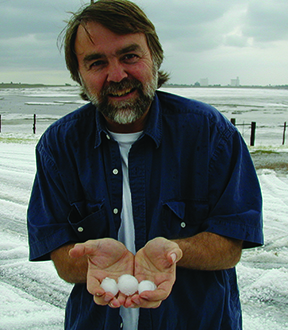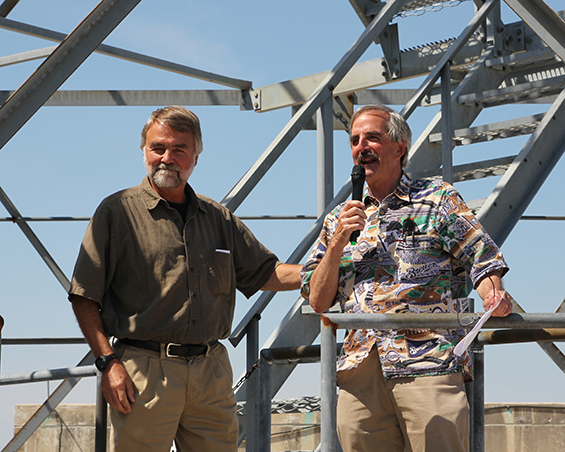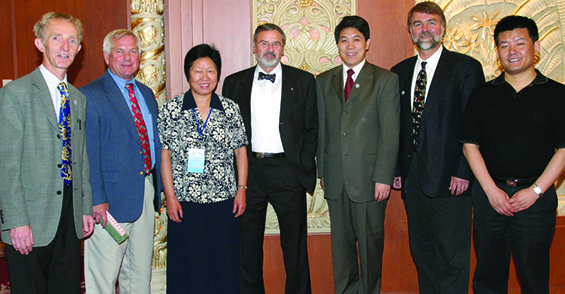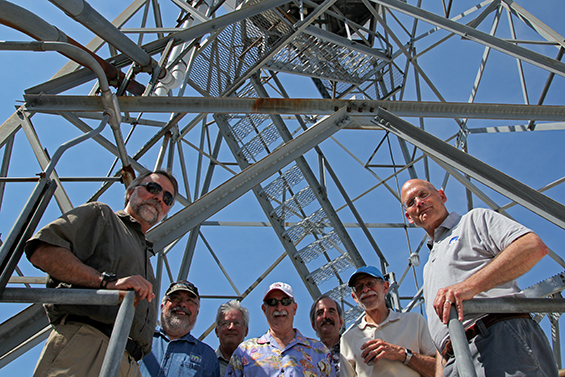Tales of People, Culture, and a Love of Weather Satellites: SSEC Executive Director Tom Achtor Retires
The path to a career isn’t always straight, but often there’s an underlying theme that brings people to the place where they are supposed to be, a place where they thrive. In the case of Tom Achtor, outgoing Executive Director of Science at the Space Science and Engineering Center (SSEC), it was a love of and interest in the environment and the earth sciences that eventually guided him to UW-Madison and SSEC. After 33 years Achtor has made the difficult decision to retire and leave the University, but not without first sharing a few tales from his career.

Tom Achtor with hail stones while storm chasing during the International H2O Project field experiment in 2002.
Nearly every story came back to people and the importance of opportunities, from Achtor’s first experiences working with his graduate advisor Professor Lyle Horn to SSEC Director Hank Revercomb offering him the role of SSEC Executive Director for Science. Achtor was quick to note that what made SSEC and its Cooperative Institute for Meteorological Satellite Studies (CIMSS) so successful over the years were the people, which he described as the “real strength” of the Center, and the culture; “the culture here was such that the leadership always shared ideas and always gave opportunities to people.”
And no doubt the research fed his interests as well. Achtor originally came to the UW-Madison in 1977 to study atmospheric science and oceanography with a goal to work on research ships. He had spent the previous two years working on a private yacht in Florida, making a number of Atlantic crossings, and as first mate he had become responsible for monitoring weather conditions. However, instead of returning to a life on the sea, he found a new passion.
“I fell in love with weather satellites.”
As a graduate student Achtor worked with Horn to investigate the synoptic climatology of developing midlatitude cyclones. Horn was very hands-on as an advisor, helping to guide the research as Achtor progressed towards his Master’s degree. Achtor was effusive in his praise of Horn, describing him as an “exceptional teacher” and crediting Horn for helping him to become a better science writer.
“[Horn] was one of the greatest people I’ve ever met. He was kind, considerate, intelligent. The first thing that impressed me about him was the fact that he could fill a board with equations, as we used to say as students. But then he would turn around and he would explain what every piece of every equation meant in the physical world.”
It was during his time as a graduate student that Achtor first became familiar with the Man computer Interactive Data Access System (McIDAS), SSEC’s revolutionary visualization and analysis system. With help from former SSEC Executive Director Bob Fox, Achtor and fellow teaching assistant John Zapotocny created a rolling McIDAS system to use in their synoptic labs (keeping in mind that McIDAS was far from a desktop system at that point) – to teach undergraduates about satellite meteorology and share the unique capabilities of McIDAS.
This experience led to a new challenge, working for Professor Don Johnson along with Russ Schneider, a fellow graduate student who was taking a break from his studies, to develop educational materials in atmospheric science using McIDAS with funding provided by the National Science Foundation (NSF). While working for Johnson was a very different experience as he was far more hands-off in his approach than Horn had been, Achtor declared that the combination of the two styles was “the best thing that ever happened to me” in developing his own approach to work.
Achtor’s efforts on the educational modules did not go unnoticed. Bill Smith and Kit Hayden, National Oceanic and Atmospheric Administration (NOAA) employees leading a small NOAA team at CIMSS, were looking to hire additional scientists at the university. Smith knew of Achtor’s role in the modules and hired him in 1980 to work on obtaining vertical temperature and moisture profiles from polar orbiting satellites, the very module topic on which they had worked together.
Achtor described the early days of CIMSS, a small emerging institute of roughly 12-15 employees, about half of whom were NOAA employees. They hardly occupied half of a floor in the AOSS building (interestingly enough, the other half was occupied by a medical student imaging bones with McIDAS as part of a research project).
“Bill Smith almost weekly would come in with a stack of yellow pieces of paper where he had scribbled out new equations for a new approach to doing temperature and moisture retrievals. He’d give them to Hal Woolf who would shake his head and say ‘Oh, no, not another version.’… But Hal was the guy who would code it and put it into the McIDAS environment. And I was the meteorologist who would then look at the resulting retrievals and give feedback on strengths, weaknesses, other things we would need to do.”
The goal was to improve the products to show that they compared well with the radiosondes – proof that Smith could take to Washington to demonstrate that these new satellites were useful and provided valuable data.
In 1985 Paul Menzel, a NOAA employee stationed at CIMSS, offered Achtor the opportunity of a lifetime – to travel to Bangladesh for 10 days to help in the country’s efforts to bring in satellite data for their early warning system; the area had been devastated by a tropical cyclone in the early 1980s that had killed more than 200,000 people. Achtor and Woolf traveled together to teach a class on satellite meteorology. It was Achtor’s first chance to travel abroad and to teach – an unforgettable experience in which he was able to “interact with the international community, to teach satellite meteorology, and like so many of our scientists have done…Bill, and Paul, and others… being able to give something to the world,” not to mention encountering a life and culture far different from his own.
A year later Smith (who had since become a university professor and a Principal Investigator (PI) with CIMSS) and Fox came to Achtor with a new job offer – to serve as the CIMSS Program Manager. Achtor initially declined, feeling strongly that he had gone to graduate school to become a scientist, not a manager. However, after much soul searching (and some persistence on the part of Smith), Achtor agreed to take on the new role. In hindsight, Achtor commented that his unique background combining knowledge of science and business had helped (he was initially a business major as an undergraduate and had family working in business). Achtor continued to stay involved in the science, although he found himself working more with geostationary (GOES-Next), rather than polar satellites, given the greater opportunities for funding in that area.
From the mid-1980s to the early 2000s CIMSS grew significantly. The total number of CIMSS staff increased from somewhere in the 30s to roughly 110. Achtor noted that Smith shared the same philosophy that encouraged opportunities within SSEC – developing more scientists as leaders and future PIs. As the institute experienced steady growth and increased funding revenue, it required more space for its staff. Little by little CIMSS sought out new rooms in AOSS. Today there are approximately 130 staff members spread out over 3 floors.
Achtor’s success as CIMSS Program Manager led to yet another job offer in 1999, that of SSEC Executive Director for Science under SSEC Director Hank Revercomb. To replace the retiring Fox, Revercomb chose to recruit three experts in the areas of science (Achtor), administration (John Roberts), and technology (Fred Best).

Hank Revercomb saying a few words about Tom Achtor at a recent SSEC gathering before Achtor’s retirement.
At that time SSEC experienced another surge in growth, at least in terms of the number of PIs. While many scientists were ready to take on the role of PI, without a PhD they hadn’t been able to obtain this status. Under Revercomb’s leadership that would change as he and his team of Executive Directors pushed to have more scientists recognized as PIs by the University. Working with the Graduate School on this issue, SSEC has increased its number of PIs to more than 30 (up from a handful in the 1980s).
Achtor described in more detail SSEC’s and CIMSS’s leadership, how they structured the administration to maximize support to scientists, engineers and their research. The key was for the administrative staff to offer the kind of support that would allow the scientists to focus on their research. As a complement to that philosophy was a hands-off approach by the Directors. While PIs would meet and discuss (and when appropriate coordinate) their efforts with the Directors, “we really want scientists to be able to do their science with the least intrusion by bureaucracy.”
Or summed up succinctly: “Let the scientists do science.” (This statement is nearly a mantra that everyone absorbs at some point in their career at SSEC.)
The transition to SSEC Executive Director had a clear impact on Achtor’s duties. He could no longer devote as much time working with students, and much of the financial oversight was shifted to new administrative hires (Jenny Hackel and Wenhua Wu). Yet it also led to new areas for Achtor to grow as a leader.
Achtor recounted the many milestones in the McIDAS timeline and how he was proud to play a role in its success (history is another passion of Achtor – not surprising as his undergraduate degree was in history). He described how the original mainframe systems were built by hand at SSEC, how they created their own graphics chips and developed the software. These mainframes, which cost $1M to produce, were shipped across the country to the various national weather prediction centers, as well as one to China.
Achtor attributed the longevity of McIDAS to SSEC’s commitment to keeping McIDAS relevant to its many users and following rapid changes in technology. As McIDAS migrated from a mainframe to a desktop system, “the availability of McIDAS to the larger community became possible, the costs came way down.” In addition to weather forecasters, private companies began taking an interest in McIDAS, and the McIDAS Users’ Group continued to grow.
After becoming Executive Director, Achtor helped guide the continued development of McIDAS, leading to the launch of McIDAS-V in 2009; the fifth generation of the software, McIDAS-V has been designed in part for multidimensional displays of hyperspectral environmental satellite data. It was important for Achtor that McIDAS look ahead to the future and move beyond two-dimensional displays – to view weather as it actually occurs – in three dimensions and with time. “You have to create the capability to not just make pretty pictures but to be able to interrogate the data.”
Achtor also noted the creation of an SSEC Media Team to improve the Center’s and CIMSS’s Web presence and to coordinate media and public relations efforts, especially in a new era that has moved far beyond print. With new technologies available for communicating directly with the public, Achtor saw an opportunity for SSEC to craft its own message and stories. Achtor also recognized the need to communicate why SSEC’s research is vital. Not only is our work interesting, but communicating our research successes will help support the Center’s mission and could help sustain it.
Achtor spent some time reminiscing about his work and role in the International TOVS Working Group (ITWG). Co-founded by Bill Smith, the ITWG meets every 18 months to 2 years to discuss research related to polar orbiting weather satellites. In the early years only the Americans had polar orbiting weather satellites while the Europeans were looking ahead to launching their own (with the Chinese, Indians, and Russians). Achtor worked on case studies using the polar satellite data to be presented and compared with the results of other groups.
Achtor noted the involvement of a number of key SSEC scientists as co-chairs of the ITWG, beginning with Smith and later Menzel. Achtor himself ran for co-chair and was elected along with Roger Saunders of the United Kingdom’s Met Office in 2002 and served until 2006 overseeing three ITWG meetings. More recently SSEC’s Allen Huang also served as a co-chair.

ITWG co-chair Roger Saunders, former ITWG co-chair Bill Smith, Chaohua Dong (former Director-General of China’s National Satellite Meteorological Center, NSMC), former ITWG co-chair John LeMarshall (Bureau of Meteorology, Australia), Guoguang Zheng (Deputy Administrator of the China Meteorological Administration), ITWG co-chair Tom Achtor, and Jun Yang (Deputy Director-General, NSMC) at the ITWG meeting in Beijing, China in May 2005.
Achtor spoke very highly of the ITWG and the work that they accomplish. “We’re all scientists and we’re all working towards a common goal and that’s trying to improve our observation of the atmospheric state and try to improve weather forecasts and weather warnings… The opportunity to meet people from all over the world, to interact with them, to work with them was one of the blessings of my career… It was a tremendous opportunity and it worked really well.”
Given that Achtor started working around the time the first U.S. weather satellites became operational, he was able to offer some perspective on the advances in engineering and science. The early years were spent demonstrating the capabilities of weather satellites. Now we not only have access to data covering the entire globe from an increasing number of satellites, but the data quality is significantly higher as is the spatial, spectral, and temporal resolution. Although the advances do not always come as quickly as scientists would like, Achtor firmly believes the launch of Suomi NPP and the coming launch of GOES-R represent the future of continually improving capabilities.
Looking back at the overall history of SSEC and CIMSS, Achtor noted the uniqueness of the Center’s research in the broader community and the recognition that has come over time. “It’s a long slow growth of doing good work and having people respect that…There’s a challenge also to do good work when you’re entirely soft money…Everything is in the peer-review proposal process. And to provide the stability and growth that we have, it’s just a statement on the excellence of our work.”
He reiterated again how important the people, culture, and opportunities were to the success of SSEC and CIMSS and what made coming to work so enjoyable for him and many others. Through his role as Executive Director he had gotten to know so many people in the Center and he enjoyed the camaraderie he had with the other Directors as they worked through the good and not so good times.

Group photo of SSEC/CIMSS Directors and senior scientists (left to right, Tom Achtor, SSEC Executive Director John Roberts, SSEC scientist Paul Menzel, SSEC Executive Director Fred Best, SSEC Director Hank Revercomb, SSEC scientist Larry Sromovsky, and CIMSS Director Steve Ackerman).
So why retire? Achtor wanted the opportunity to pursue other interests while he was still “fairly young.” Several years ago he gradually began planning for his retirement, and then a year ago began discussing the specifics with the other Directors. They developed a plan on who might take on his duties and leadership roles, tapping Wayne Feltz as the CIMSS science manager, Dave Santek to guide the future of McIDAS, and Jean Phillips to lead the Media Team. Once those pieces fell into place, he felt he could move on.
While Achtor is setting out on a new path, that initial theme, his curiosity about the earth will surely continue to guide him, whether he is traveling and exploring new places or eagerly tackling a stack of geology books that awaits him at his home in the north woods.
by Leanne Avila
